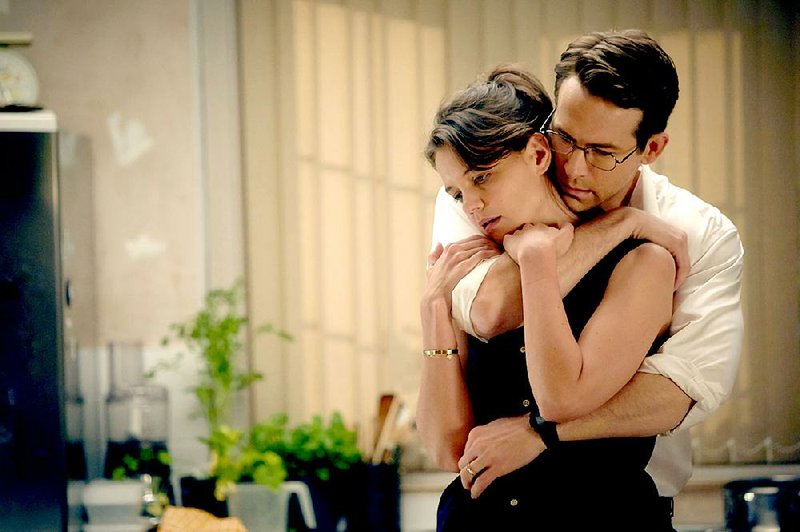Movies collapse more often than they rally. Woman in Gold is the rare film that limps programmatically along for most of its running length before closing in a surprisingly satisfying fashion. It's a shame, because most moviegoers are likely to give up on Simon Curtis' legal melodrama long before its strong finish. But we can at least credit the movie for finally connecting after 90 minutes of predictably earnest brow knitting.
That's not to say the true story underlying this fictionalized fable isn't fascinating -- Maria Altmann, played here with regal bearing and an abrupt Viennese accent by Helen Mirren, was a real person with a remarkable biography. A displaced Austrian-Jewish aristocrat who escaped Europe with her opera singer husband before World War II, Altmann (who died in 2011) spent years trying to recover a number of Gustav Klimt paintings stolen from her family by the Nazis.
Woman in Gold
86 Cast: Helen Mirren, Ryan Reynolds, Daniel Bruhl, Tatiana Maslany, Max Irons, Katie Holmes, Charles Dance, Antje Traue, Elizabeth McGovern, Jonathan Pryce, Frances Fisher, Moritz Bleibtreu, Tom Schilling, Allan Corduner, Henry Goodman, Nina Kunzendorf
Director: Simon Curtis
Rating: PG-13, for some thematic elements and brief strong language
Running time: 109 minutes
The most famous of these was a (rather garish) art nouveau portrait of her aunt, Adele Bloch-Bauer, embellished with yards of golf leaf, that ended up in the Belvedere Palace, Austria's national art museum, after the war. The painting, renamed Woman in Gold, was considered a national treasure by the Austrians, something like their Mona Lisa.
The film opens in the 1990s with Maria, an assimilated Californian, scattering a few dry words over the fresh grave of her sister. Later, going through the deceased's effects, she discovers paperwork that suggests she might have a claim to the painting hanging in the Belvedere. So she engages the services of callow struggling lawyer Randy Schoenberg (a badly miscast Ryan Reynolds) to look into the possibility of recovering her property.
Like Maria, Randy has deep ties to Austrian-Jewish culture -- his grandfathers were the composers Arnold Schoenberg and Erich Zeisl. While the film makes much of Randy's relation to the expressionist Schoenberg, it doesn't mention Zeisl, who also fled Europe after the rise of Hitler, eventually settling in Hollywood where he wrote music for films such as The Postman Always Rings Twice (1946) and Abbott and Costello Meet the Invisible Man (1951). While both men died years before Randy was born, the elision underlines one of the inherent problems in creating a popular entertainment from a complicated and nuanced story: One wonders what interesting complications of the "true story" may have been sanded away in order to fit it into such a standardized Hollywood template.
For example, the pivotal work of Austrian investigative journalist Hubertus Czernin (played here by Daniel Bruhl) is slighted; the crusader becomes instead an Austrian gofer who abets Maria and Randy in Vienna. And the moral question of whether Adele's actual wishes should be honored -- before she died in 1925, she expressed a desire that her portrait (actually portraits, but never mind) be donated to the Austrian government. While Adele didn't foresee their theft, or the rise of the Nazis, the film discounts her wishes on technical grounds (she wasn't the actual owner of the paintings, her husband was).
While we might all agree that Maria was justified in trying to retrieve the paintings (actually Maria was just one of the Altmann family members involved in the case), things were never so black and white as the movie implies. But then, I guess if you want a realistic depiction of legal machination you could watch Better Call Saul.
That doesn't mean Mirren isn't fun to watch as Maria, or that we don't feel a little blast of righteous indignation as she and Randy battle against smug and dissembling Austrian bureaucrats. But as the film plods along, hitting all the predictable beats in a clockwork script, a more compelling story emerges in the background as the beautifully designed backstory set in the salons of '30s Vienna (where Maria is played by Orphan Black breakout star Tatiana Maslany). At first, these discursions into Maria's memory seem convenient and romantic; by the end of the film you might find these stylized interludes better realized and more affecting than the courtroom.
If you've seen The Monuments Men or the documentary Adele's Wish (2006) or read Lynn H. Nicholas' 1994 book The Rape of Europa (which was subsequently made into a documentary), you might have an inkling of how the Nazis systematically looted the art treasures of occupied countries. In a way, Woman in Gold is a reductive and trivializing take on these events, as it makes it seem as though Maria's moral victory was subordinate to the fabulous wealth the retrieval of the paintings ultimately brought.
That said, there's nothing all that wrong with Woman in Gold. It's simply a forgettable, pretty gloss on a subject that deserves a deeper and less heavy-handed treatment than Hollywood products are equipped to give.
MovieStyle on 04/10/2015
